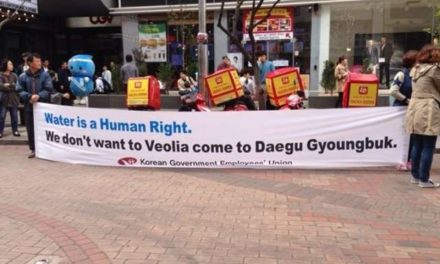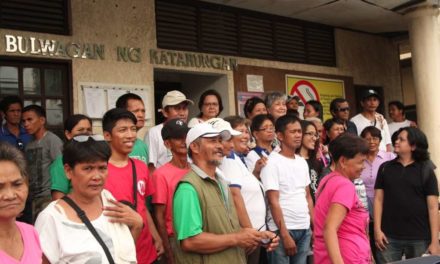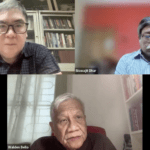Presentation by Shalmali Guttal, Focus on the Global South at the conference:
The Role of Multilateral Development Banks (MDBs) in the process of
Development in Vietnam
May 5-6, 1999, Hanoi, Republic of Vietnam
To begin, I would like to express my sincere appreciation and thanks to the Conference organisers and the Government of Vietnam for inviting me, and facilitating my trip to Hanoi. Today, I would like to share with you some of the main anomalies I see when I put development and Multilateral Development Banks (MDBs) together.. Coming from a civil society background, I will focus on the experiences of civil society in relation to the development policies promoted, and often enforced by the MDBs.
I would like to begin by locating this discussion in a larger social development framework. All human activity, whether social, cultural, economic, commercial or political is mediated through informal and formal avenues and institutions. The more easily recognisable of these avenues and institutions are those related to the State and the market. By the State, I refer to the highest accepted power or authority in a society that imposes a definite order, which in turn permits and enables the functioning of specific political, economic and social systems. The State includes government structures and procedures, legal and regulatory codes and mechanisms, social services, law and order, and so on. By the market, I broadly refer to the realm of trade, exchange of goods and services, and commercial transactions, whether through physical market places, electronic communication, or transnational banks. There still remains a huge area of human activity that majority of us are rooted in and which is categorised neither as the State, nor as the market and broadly referred to as civil society. Civil society is the realm in which the people of any society interact, and it encompasses religious institutions, citizens’ associations, workers’ unions, non-governmental organisations, the media, peoples’ movements, cooperatives, academic institutions, and so on.
The State, market and civil society are all integral components of society, and have traditionally had their place and functions. But, they have never operated independently of one another; on the contrary, they have strongly influenced and been influenced by one another. The State has had the responsibility for determining and protecting the overall political and regulatory frameworks for social, political and market institutions and processes to operate within, while at the same time ensuring a policy environment that facilitates equitable social, human and economic development. In that a State is mandated to act on behalf of its citizenry, civil society has had–in most cases–a dynamic relationship with the functioning of the State, and has articulated and represented the various interests and needs of diverse social groupings. However, dramatic political and economic changes over the past thirty odd years have resulted in a blurring of these roles and functions, especially as market processes and institutions have expanded to occupy ever-larger spheres of human existence.
In many countries, the transition from centrally planned or command economies to liberal, free market orientation, the impacts of structural adjustment programmes, and the expansion of neo-liberal economic development agendas have severely undermined the capacities of governments—particularly in the south—to act according to their originally envisioned mandates of determining national development policies and protecting their citizenry–particularly vulnerable groups– from social, political and economic inequities. The liberalisation and privatisation processes accompanying the aggressive spread of the neo-liberal, growth oriented development model coupled with a steady decline in State intervention and responsibility in protecting the public sphere have led to a deepening of absolute poverty and already existing inequalities in many countries. In the poorer countries of the South, this has seriously impacted the access of vulnerable sections of society to even the most basic social services.
In the wake of these changes, responsibilities for delivering social services and maintaining social safety nets have been increasingly transferred from the State to civil society and market actors in a variety of combinations. A common trend prevalent in most developing countries for several decades has been the presence of local and international NGOs specialising in sectoral service provision, especially in such areas as health, education, environmental management, micro-credit, income generation, and so on. In several developed and developing countries, health, education and credit facilities have become increasingly privatised, with the State maintaining control over a bare minimum number of facilities. Close to home here in mainland Southeast Asia, large scale infrastructure development projects have brought the State and Market into imaginative alliances, where equity contributions and financing arrangements have required State agencies to compromise on important issues such as environmental and financial regulations, rights of citizens to land and water, and control over the costing of public services. In many projects–clear examples can be found in energy sector projects in the Mekong region–NGOs have partnered with government agencies and private companies to both provide technical services, as well as to attend to civil society demands of consultation and participation.
Clearly, easy delineations of roles and responsibilities between State, civil society and market actors are becoming increasingly difficult to maintain. This provides particular reason to critically assess the roles and functioning of the MDBs.
On one hand, MDBs are banks and hence market institutions. They lend money for fixed periods of time and under specified terms, they charge interest according to those terms, and they collect from their debtors at the end of loan periods. Like most commercial banks, they have a number of different loan programmes and schemes with varying interest rates, payback periods and conditionalities. However, unlike commercial banks, MDBs also act as international development agencies, and significant proportions of the credits issued by them are for economic development purposes. Credits from these banks come with entire packages of economic and by extension, political conditionalities without compliance to which, loans are not made or renewed. These conditionalities almost always call for major restructuring by borrowing countries in the sectors for which the loans are provided and in the case of IMF-World Bank credits, restructuring is often required at both the national and sectoral levels. Further, compliance with loan conditionalities are often linked with the availability of bilateral and other multilateral development assistance to debtor countries in the form of grants, technical assistance, and equipment for social sectors such as health, education and the environment. As a result, the terms and conditions attached to these multilateral credits have increasingly dictated the development agendas in borrowing countries. Many loan programmes–most notably the structural adjustment programmes of the IMF-World Bank, and sectoral reform and privatisation programmes of the Asian Development Bank (ADB)–have been instrumental in redefining and reshaping economic, social and governance policies and institutions in borrowing countries, especially in the South. In this regard, MDBs have assumed many of the powers that have traditionally rested with the State.
The impacts of structural adjustment programmes have been documented quite exhaustively in a variety of studies by public, private and civil society institutions, including UNICEF and the World Bank itself. According to independent estimates, more than 4 billion people in over 100 countries felt the impact of structural adjustment programmes between the early 1980s and mid 1990s. Traditional adjustment measures have included: the amendment of legal frameworks to make them as market and private-sector friendly as possible, privatisation of public goods such as water and electricity, the introduction of user-pay systems for basic social services, financial sector reform, encouragement of cash crops for export, removal of social subsidies, creation of a land market, civil service reform and decrease in protection of the labour market. Such measures, coupled with the IMF’s stabilisation measures, are intended to "…reduce internal and external deficits, increase efficiency in the economy and reduce government expenditure." The impacts of structural adjustment programmes have not been homogenous, and can be differentiated by the different types of policy measures introduced, the political and economic context of the country, and characteristics such as class, gender and age of different population groups. True, growth as measured by traditional indices such as GDP and GNP may actually have increased in some countries under structural adjustment. However, it is widely acknowledged that the economic benefits from such restructuring have largely accrued to small exclusive enclaves of society, to those groups with pre-existing social and political advantages, access to capital, and specific professional skills that are marketable. on the other hand, already resource poor and marginalised sections of the population have been further alienated from the benefits of this economic growth, thus deepening inequities, poverty and dis-empowerment.
A particularly notable policy requirement that accompanies MDB loans and grant assistance is the privatisation of public services, facilities and institutions at both the national and sectoral levels. Privatisation is a central structural tenet of the neo-liberal development paradigm so aggressively promoted by a number of multilateral and bilateral institutions. Given that public facilities and institutions are intended to promote equitable access to services and opportunities by all members of society, privatising them is equivalent to privatising development itself, whether social or economic. Issues of access and quality are left up to the rules of the market rather than standards of equality, fairness or social justice. In mainland Southeast Asia, the ADB has taken the lead in vigorously supporting the privatisation of infrastructure development and management, for example the building of roads, bridges, transport facilities, energy production and distribution facilities, market places, and so on. Such privatisation has been a growing global trend with serious implications for vulnerable groups in rich and poor countries alike. However, it has much more far reaching effects in countries with already weak social and public infrastructure to begin with.
Under the auspices of the Greater Mekong Subregion Economic Cooperation Programme, the ADB has promoted the appraisal and planning of large-scale infrastructure development, particularly in the transportation and energy sectors. Many of these projects necessitate the mobilisation of large amounts of capital that far exceed the combined capacities of recipient governments and the international donor community combined. The ADB has not only been willing to provide significant credits and grants for these projects, but more important, it has facilitated and promoted co-financing arrangements among the private sector in its member countries, transnational corporations, and private international financial institutions. However, all infrastructure projects do eventually entail counterpart contributions from the host country in some form or the other, whether direct financing, or rights to land, water or other resources. More often than not, these contributions involve political and economic compromises that minimise risks to the private sector and contradict public interests. It must be remembered that whatever the financing arrangement—whether single tranche loans, joint ventures, BOT or BOOT schemes, etc.–bulk of the moneys that come in for these projects will be in the form of credits, and represent future claims by external interests to the resources of the recipient country. The interests of the private sector are protected and promoted by the ADB. But what are the implications of this for the capacity of the State to maintain sovereignty in decision making, and protect the interests of its population?
Although the International Monetary Fund is not an MDB, it has more often than not acted in concert with the World Bank. Also, the genesis and evolution of power in both institutions is closely linked, and they are often referred to as the Bretton Woods twins. The IMF and the World bank were born over 50 years ago in New Hamphire, USA with clear and complimentary, but narrowly specific mandates that were primarily economic in nature. The earliest member of the World Bank group was the International Bank for Reconstruction and Development (IBRD), which was originally mandated to assist with the physical reconstruction of Europe after the devastation of the Second World War. The WB started to turn its attention to the developing world towards the end of the 1950s, through the International Development Organisation (IDA) and the International Finance Corporation. The IMF’s original mandate was limited to trade and exchange rate stabililisation measures in the context of the gold standard and fixed exchange rates. Neither of the institutions were established as developmental organisations, but rather as lending institutions to facililitate much needed capital in the post-war period. Interestingly, despite tremendous changes in economic and political environments the world over, and gradual assumptions of new roles and function by the IMF and the World Bank, their respective charters have not altered significantly since their inception.
The ADB was established in the mid-sixties, again with a specified mandate to providing credits in the Asia region. The original agreement establishing the ADB prohibits the ADB leadership and staff from engaging in political activities or considering factors other than economic in their decision making. But of course, it is extremely difficult to separate economic from political; decisions about how the resources of a society should be used are shaped by those who can influence this decision making and are in the final analysis, political decisions. Over the last 30 years the operational environment of the ADB has changed a lot: political and social climates in Asia have undergone profound transformations and new concepts in development have emerged that demand involvement from a variety of actors outside the State. Because of globalisation economic events in one part of the world are quickly reflected in another part of the world. In concert with these changes, the ADB too is moving away from its traditional role of a bank towards a broader based role of a development institution.
Both the World Bank and the (ADB) are constituted of member countries that can be considered shareholders of the banks. In line with the operating principles of shareholding, decision-making powers in both institutions are weighted according to the amount of capital stock held by their different members. In both banks then, the richer and developed countries dominate decision making about internal structure and policies, and overall programmatic goals and directions. Although the ADB’s development ideology and operational strategies have reflected trends prevalent in its Asian member states, by virtue of its composition and expanded role, the ADB is also an international development institution, albeit operating in the Asia region. Among its decision-makers are representatives of the industrialised western countries, and it is important to note that the economic paradigms and strategies promoted by both banks reflect the political, economic and commercial interests of its more powerful shareholders.
The economic and devellopment policies promoted by the MDBs are not simply mechanistic or technical interventions, but rather reflect their rooting in the neo-classical economic growth theory. Put simply, neo-classical economic growth theory is based on the assumptions that in any country, development and progress are not possible without high levels of economic growth, which can be measured and appropriately represented by indicators such as Gross National Product (GNP) and Gross Domestic Product (GDP). The maximisation of economic growth is expected to lead to the creation of economic wealth for society as a whole and subsequent economic welfare for all its citizens. As the overall economic pie of a country is maximised, the income and well being of its citizens will increase since the benefits of economic growth will "trickle down" to all members of society. However, in order to achieve such growth, the role of the State needs to be reduced, and market institutions need to be allowed greater leeway, thus setting the stage for a laissez faire free market. The market is somehow considered as the most efficient and neutral allocator of economic resources, and providing greater freedom to the market along with limiting State intervention in the distribution of resources—for e.g., through taxes, removal of subsidies, etc.—is expected to generate new wealth which will eventually trickle down to the poorer classes, and society as a whole would benefit.
However, practical experiences and empirical evidence over the past few decades show that although it is possible to achieve levels of economic growth through this model, this growth is neither equitable, nor sustainable in the longer term. Economic benefits have not trickled down in the expected manner and time frame to all citizens of society. Today we are faced with the paradox that in an era of unprecedented wealth, there are more poor people and greater environmental damage then ever before, a rapidly dwindling natural resource base and drastically reduced access among huge sections of the world’s population to basics such as food, water and livelihood opportunities. The point here is not that growth in and of itself is bad or not needed, but rather, what kind of growth justifies the massive redirection of public resources that we have witnessed in the last few decades? Growth for what purposes and for who? Growth through what means, and at what costs? How can growth be translated into real and concrete enhancement in the quality of lives of people who are poor, socially vulnerable and marginalised from decision-making? Not surprisingly, such questions have been raised by a variety of civil society and State actors, especially those who are closely linked with the daily struggles of that vast majority who growth was supposed to benefit, but in fact, did not.
This is not the place to go into a full-fledged dissection of the economic growth paradigm. However, recent experiences show that in order to yeild long term, sustainable and wide spread benefits, economic growth must be driven by social and human development priorities, and not vice versa. If growth is to contribute to equity, it must be redefined to favour equality and genuine distribution of both opportunities and gains. This in turn implies that macro, and particularly economic policies must be subordinated to social and human development goals, and located in a development framework that facilitates achievement of these goals. This means conscious and concerted attempts to identify strategies that contribute to both the depth and breadth of human development, and not simply to accelerated economic growth. This also means that the MDBs (and the IMF) should be accountable to sustainable human and social development criteria, and not attempt to replace the State or direct civil society in shaping devlopment policies and agendas.
But how do we go about changing conceptual understandings of development and trying to seek appropriate policy responses to facilitate sustainable human development? The fact that the development debate has reached where it has today is because of the active struggles of civil society—people’s movements, citizens’ associations, trade unions, NGOs—and sensitive ears among government institutions. In response to the challenges posed by these actors, the MDBs have actually introduced a number of reforms within their institutions. They have introduced grievance proceedures, information disclosure policies, operational directives and guidelines for projects that affect vulnerable groups such as indigenous peoples and poor women, and established sectoral groups and teams to pay greater attention to such issues as the environment, resettlement, education, health and people’s participation. They are now talking about good governance and have agreed to independant assessments of their projects by experts outside the institutions. The World Bank has agreed to a global, multi-level review of the impacts of structural adjustment, which in turn has given rise to joint government and civil society research and assessment processes. However, the core principles and fundamental tenets of the MDBs do not appear to have changed. The MDBs seem to have fully retained the original "bank" mandate implied in their names, while making superficial changes in their operating styles in order to legitimise the development functions—also implied in their names.
Such cosmetic shifts can be tremendously misleading since they lead many of us to believe that the MDBs are reforming, while masking the fact there has been little fundamental change in their definitions of development. I would like to emphasise that I see the debate not simply as one of "us and them," but rather, as a more fundamental issue of how we view development. Many civil society organisations support the neo-classical, growth oriented model of development, and have been more than willing to enter into partnerships in large MDB led initiatives without questioning their longer term impacts and costs. Others organisations, attracted by the rhetoric of public consultation, participation and the need to improve implementation strategies, have taken on technical assistance and service delivery roles in MDB designed projects, but have also not challenged current development practices. Instead, they have unwittingly provided rationales for the viability and sustainability of such projects through their own involvement in mitigation efforts.
Civil society actors and local governments, more than most other institutions, are able to see clearly the positive and negative impacts of different development strategies and approaches. Unfortunately, these lessons have not fed back into policy making in a sufficiently substantive manner so as to effect real change in development policies. It is true that many recent large-scale projects–especially those that entail the transformation of natural resources—have required several stages of public consultation. But while these consultations may have led to improvements in form, they do not appear have had any significant influence in reconsidering the very premise on which the projects are based.
An important question for civil society to consider in the issue of engaging with the MDBs is who sets the terms of engagement? Many organisations have chosen to not enter into any discussions with the MDBs either because they do not believe that such engagement will lead anywhere useful, or because they have felt exploited in previous encounters through their own powerlessness in fora that they were ill prepared for. Civil society and local government actors in the South are usually overworked and under-resourced, and are unable to access the information, skills and knowledge required to assess the full implications of many development initiatives and policies. Such lack of capacity is often a result of longer term conditions such as low levels of formal education among affected peoples, lack of opportunities for knowledge upgrading among government staff, too few government staff because of budget cuts, and at times, systematic concealment of relevant information by those who stand to benefit from specific initiatives. In such contexts, dialogue and negotiation can never be on equal terms, and only serves to further cosmetic beliefs that policies and programmes are developed through participatory, consultative processes. It is crucial then, that engagement with those who influence development policies and agendas facilitate authentic participation of all those who would be affected by them. This calls for greater and more systematic efforts by civil society and local governments to strengthen their own capacity to understand and assess policy making. And if the MDBs are indeed committed to the ideals of participatory, sustainable human development, they will certainly not object if the terms of engagement are redefined by the eventual beneficiaries of their loans.
The inherent characteristics of civil society organisations—grassroots orientation, knowledge about local contexts and reality, sensitivity to the nuances of various social-economic groups, flexibility, mobility, etc.—render them potentially powerful actors in re-shaping development agendas, if they can find ways to feed their expertise into policy making within their respective societies. Some concrete ways by which this could be done are: taking on increased development education roles for the public and local government, integrating service provision with critical debates about key issues related to these services, promoting action research through which communities can strengthen their abilities to articulate development paths appropriate to their contexts, assisting the State to build strong, local governance bodies to monitor development and other policies, monitoring changes in society and identifying gaps in social services, and of course, direct advocacy with their governments about development policies and impacts.
In conclusion, I would like to reiterate that although the State, civil society and the market all have important roles and functions in human activity, the role of the market has expanded to unhealthy proportions in dictating development agendas. It is now eventually up to the State and civil society to restore the balance of power in decision making about development so that it is determined by the needs and ideals of authentic social and human development.
REFERENCES
Cavanagh, Joan and Robin Broad: (1999) The Death of the Washington Consensus? Paper prepared for the Conference "Economic Sovereignty in a Globalising World," Focus on the Global South, March 1999.
George, Susan: (1999) A Short History of Neo-Liberalism: Twenty Years of Elite Economics and Emerging Opportunities for Structural Change, Paper prepared for the Conference "Economic Sovereignty in a Globalising World," Focus on the Global South, March 1999. Jokinen, Janne: (1998) The Political Role of the Asian Development Bank in the GMS, Report prepared for the Department of International Development Cooperation, Ministry of Foreign Affairs, FinlandMalhotra, Kamal: (1998) Civil Society Organisations in the New Millenium and their Potential Roles for Enhancing Sustainable Social and Human Development,
in Peace Forum Vol. XIV, No. 26/Winter, 1998 Malhotra, Kamal: (1998) Rethinking Development, Paper prepared for UNESCAP.Malhotra, Kamal: (1999) Reviewing the Governance of the Global Economy, Paper prepared for the Conference "Economic Sovereignty in a Globalising World," Focus on the Global South, March 1999. Tandon, Yash: (1999) The Keynesian State, Paper prepared for the Conference "Economic Sovereignty in a Globalising World," Focus on the Global South, March 1999.









